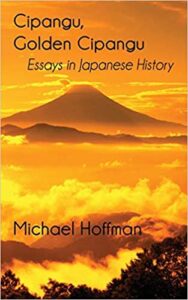Cipangu, Golden Cipangu: Essays in Japanese History by Michael Hoffman
Virtualbookworm.com Publishing, 2020, pp.298
Book Review by John Dougill

Michael Hoffman’s literary and historical articles for The Japan Times have always come across as remarkably well-informed, remarkably well written too. It led me to read his first collection of miscellaneous pieces called In the Land of the Kami, and it led me to acquire this book too, the title of which refers to Marco Polo’s imaginative description of Japan which inspired Christopher Columbus to set off in quest of it.
There are sixty-three topics in all, taken from the monthly (and ongoing) column called The Living Past. They range from consideration of the Jomon Period to relatively unknown works of modern literature. Along the way Hoffman offers cultural insight and an ability to describe the complex in clear-cut terms. Throughout the book the author maintains a keen sense of judgement and a pristine style. No waffle here, no vagueness, no obfuscation.
The trenchant sentences sound like aphorisms. ‘Truth is a Sordid Business,’ begins one story. There is a certainty about the prose that suggests the author has not only mastered his material but stands above it with sufficient oversight so as to identify the salient points. It’s as if maybe, allegedly, perhaps, seems and sometimes have been ejected from his vocabulary.
The result is an edifying combination of concision and instruction. He covers the Gempei War in one informative paragraph. He sums up the Meiji Period as walking a thin line between science (Western technology) and myth (Japanese tradition). He shows how poetry in the Heike Monogatari is as highly valued as swordsmanship and valour. And in a brief summary of Japan’s debt to China we learn there were 19 official missions between 607-838, and that a third of those who set out perished before their return.
A hundred years ago Lafcadio Hearn was much admired for writing sympathetically of Japanese culture and raising awareness in the wider world. Hoffman is very much in that tradition. He not only sheds light on different aspects of Japan, but does so in a way that raises the interest of his readers. Jomon Japan, for instance, is championed as a progressive era of peace and varied diet – ‘Jomon Japanese were more active traders than medieval Japanese,’ he tells us.
In contrast to the norm elsewhere, Hoffman sees the Japanese tradition as marked by ‘the struggle to be unfree’. Obedience, servility, self-sacrifice, the suppression of ego are the underlying themes of the country’s heroic models, and its epitome was reached in the practice of junshi (following one’s master into death). Donald Richie and Lafcadio Hearn came to much the same conclusion.
If one were forced to make a criticism, it would be about the Contents, for they give little indication of the actual content. ‘Freedom’ runs a title, which could concern just about anything. In fact it relates to the first political parties in Meiji times. ‘Let’s Take a Break,’ suggests another title, which gives no clue to it being about Heian literature. Incidentally, in these Corona crisis times with Kyoto devoid of tourists, Hoffman notes that tenth-century Heian-kyo had a population of 150,000, of which the nobility were just 10,000. We think of Kyoto being ’empty’ now, but imagine all that space and all that nature with so few people around.
And that in the end is what Hoffman manages to do so well – make us imagine. Thanks to his limpid prose, the pages of history come alive and glisten with appeal. The clue is in the title: Cipangu, Golden Cipangu.
******************
Book available from amazon Japan or amazon.com






Recent Comments